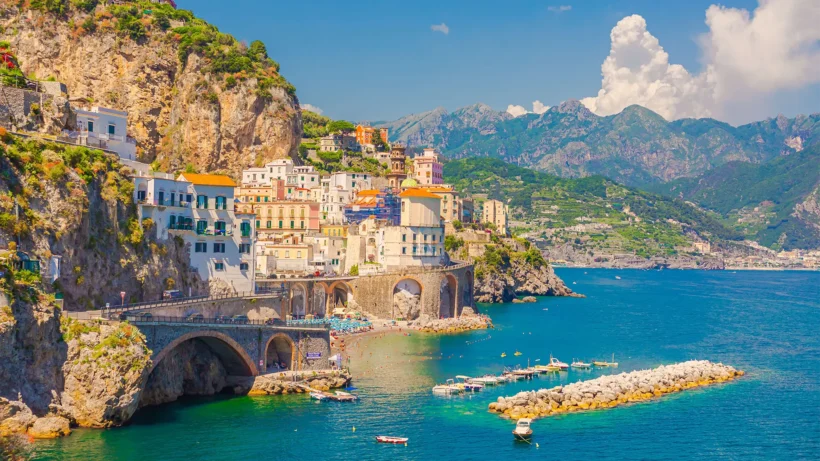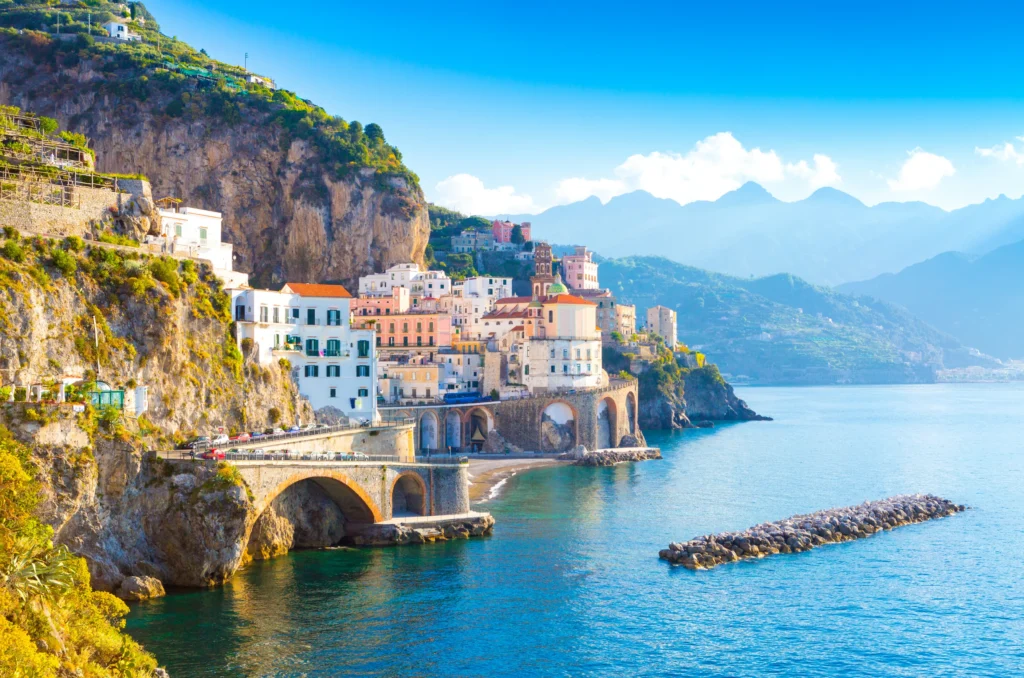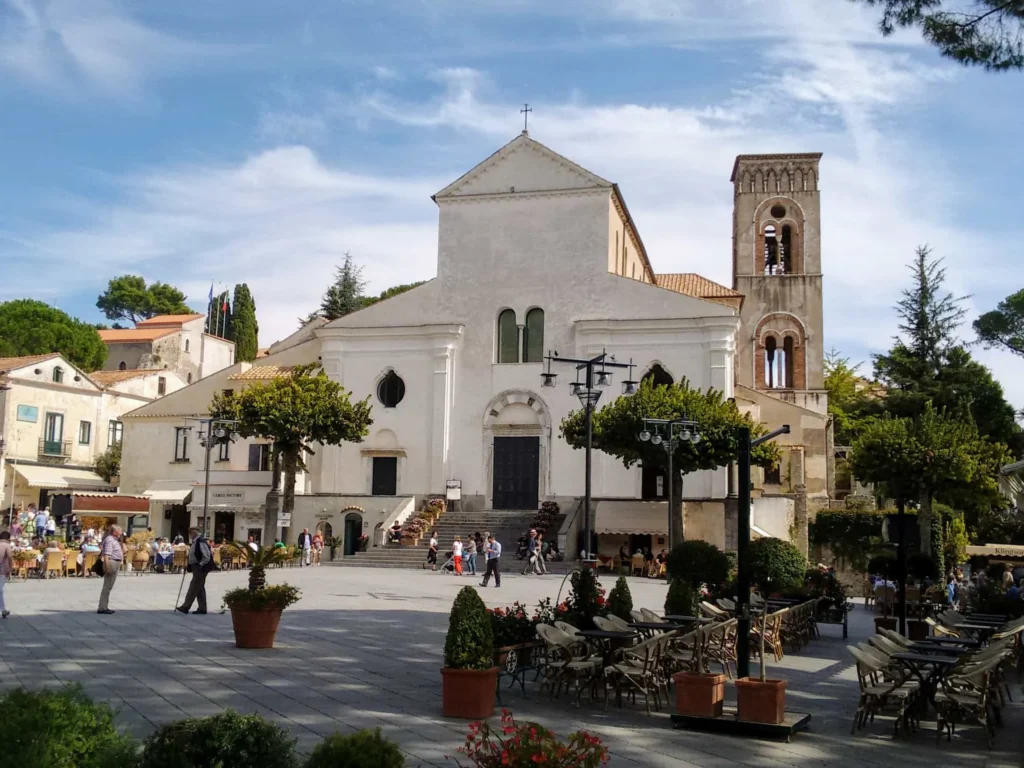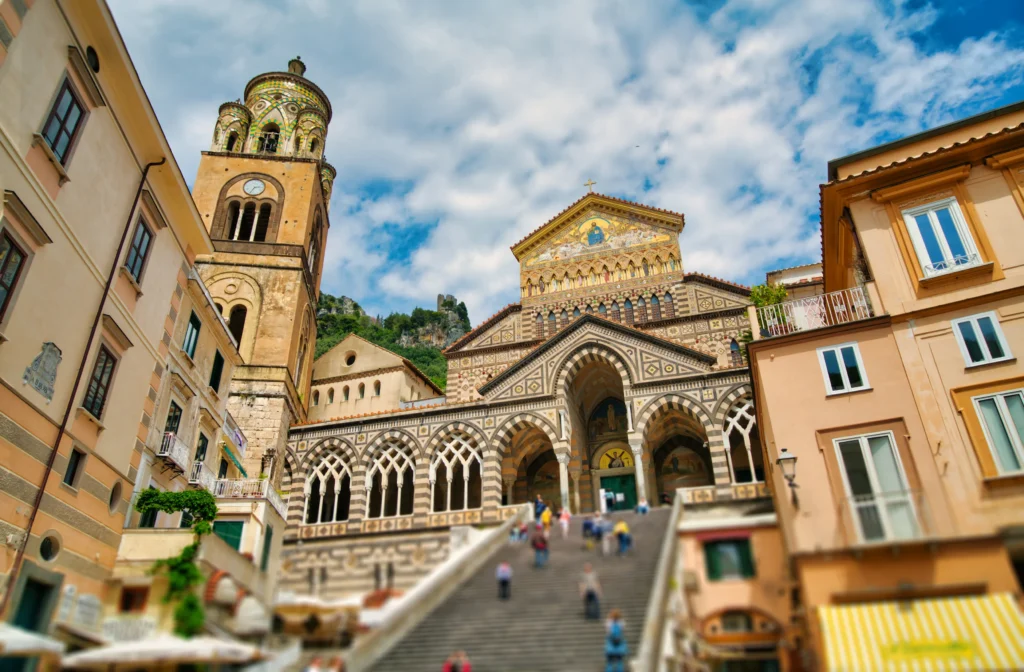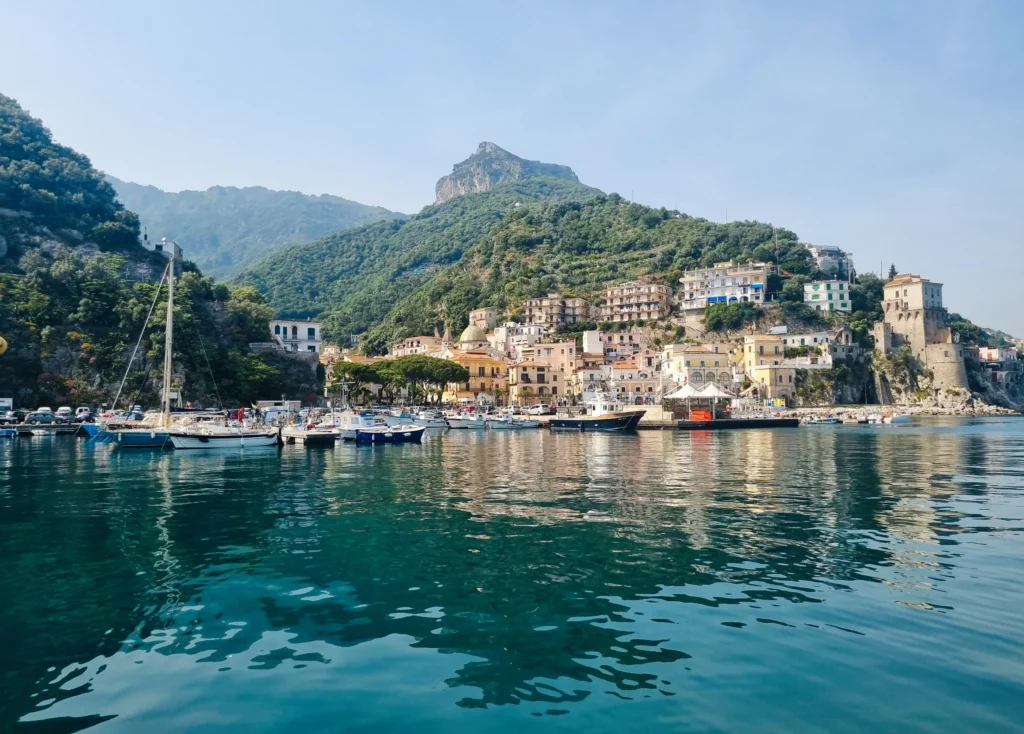The scent of lemon groves drifts on the sea breeze, mingling with the salt air as the Tyrrhenian sea sparkles far below. Sunlight spills across whitewashed houses clinging to cliffs, their balconies draped in bougainvillea. On the narrow cobblestones, time slows — not because the world demands it, but because the Amalfi Coast invites you to.
This isn’t just a coastline. It’s a rhythm, a feeling, a way of moving through life with a little more intention. Here, every glance reveals another secret — a hidden cove, a quiet chapel, a trattoria where the pasta tastes like home.
In this guide, we’ll help you travel deeper. Beyond the postcard views and the tourist routes, you’ll discover the authentic heart of the Amalfi Coast — a place where history, culture, and natural beauty come together in unforgettable harmony.
Quick Facts at a Glance
📍 Location
Campania region, Southern Italy — a 50 km stretch of dramatic coastline along the Tyrrhenian Sea
💰 Currency
Euro (€)
🗣️ Language
Italian (English is widely spoken in tourist areas)
🏛 Known For
Cliffside villages, lemon groves, scenic drives, beaches, and fresh seafood
🧭 Ideal For
Families with toddlers, kids, or teens looking for a mix of nature, culture, and sea
A Brief History & Cultural Context
Long before the Amalfi Coast became a dream destination, it was a power in its own right. In the 10th and 11th centuries, Amalfi thrived as a maritime republic, trading across the Mediterranean and rivaling Venice, Pisa, and Genoa. Its sailors brought back spices, silks, and ideas, leaving behind a legacy of boldness and independence that still colors the region today.
That spirit of resilience is also rooted in the land itself. For centuries, locals have cultivated steep terraces of lemons (limoneti), their golden fruit now as iconic as the cliffs they grow on. In Vietri sul Mare, artisans continue the tradition of hand-painted ceramics, their vibrant patterns decorating piazzas, kitchens, and cafés. And throughout the year, the towns come alive with festivals — processions, music, and fireworks that echo celebrations held here for generations. You’ll still see saint’s-day parades winding through village streets and hear classical music drift from Ravello’s summer festival. In workshop doorways, master ceramists hand-paint tiles as families tend the terraced limoneti that supply everything from lemon granita to limoncello.
To walk the Amalfi Coast today is to step into this living history. Every church bell, every lemon grove, every piece of painted pottery connects you not only to the present moment but also to a culture that has thrived here for a thousand years.
The Best Time to Visit the Amalfi Coast
The Amalfi Coast is beautiful year-round, but the experience changes dramatically with the seasons. Choosing the right time depends on whether you crave lively beaches, quiet walks, or something in between.
Spring (April–May)

Mild temperatures (18–24°C), blooming wildflowers, and lighter crowds make spring one of the most rewarding times to visit. It’s perfect for hiking trails like the Path of the Gods before the summer heat sets in.
Summer (June–August)

The high season brings hot days (26–32°C), vibrant festivals, and buzzing beaches. It’s the best time for swimming and nightlife, but also the most crowded — and hotels book out months in advance.
Autumn (September–October)

Warm seas and golden sunsets linger, with daytime highs around 22–28°C. This is harvest season, when vineyards and lemon groves are at their peak. The crowds thin, giving the coast a more relaxed feel.
Winter (November–March)

Quiet streets and cooler weather (10–15°C) make winter the reflective season. It’s atmospheric, but many hotels, restaurants, and ferries operate on reduced schedules — so it’s best suited for those seeking solitude over convenience.
Getting There & Around
If you’re wondering how to get to the Amalfi Coast, the journey usually begins in Naples or Rome. Most travelers fly into Naples International Airport (NAP), the closest major gateway, and reach the coast in about 1–2 hours by car, bus, or ferry. Another popular option is taking a high-speed train from Rome to Naples or Salerno — from Salerno, ferries connect directly to the coastal towns, making it one of the smoothest routes.
Once you’re here, getting between towns is an experience in itself:
- ⛴️ Ferries – The most scenic and stress-free way to travel, connecting Positano, Amalfi, Salerno, and more.
- 🚌 SITA buses – A budget-friendly choice, though often crowded in summer.
- 🚗 Driving – Offers independence but comes with challenges: narrow roads, hairpin turns, and limited parking. Most visitors choose to park once and rely on ferries or buses instead.
🧭 JourneyGazer Tip
- Sit on the right side of the ferry from Salerno to Amalfi for the best coastal views as villages appear one by one.
- Don’t overlook Salerno as a gateway — its train station connects directly to Rome and Naples, and ferries from here are often less crowded than those from Naples.
👉 For a complete breakdown of all transport options, from ferry schedules to driving tips, see our detailed guide: Getting Around the Amalfi Coast.
Unforgettable Things to Do on the Amalfi Coast
The Amalfi Coast isn’t just a place to see — it’s a place to live through experiences that linger long after you’ve left.
Discover Amalfi Cathedral
In the heart of Amalfi, the striking Duomo di Sant’Andrea rises with striped arches and a dramatic staircase, drawing you upward into centuries of history. Inside, golden mosaics and quiet chapels tell stories of faith and artistry, while the cloister offers a moment of calm away from the bustling piazza.
Best for
History lovers, architecture enthusiasts, and travelers seeking a quiet spiritual moment.
Key Info
- Location: Piazza Duomo, Amalfi town center
- Time Needed: 30–45 minutes
- Entry: €3 adults, free under 6
Tips for Visiting
- Arrive early to avoid crowds in the main nave.
- Dress modestly — shoulders and knees covered.
- Don’t miss the Cloister of Paradise, often overlooked by tour groups.
🧭 JourneyGazer Tip
Step into the cloister in midday — its shaded arches and palm trees make it one of the most peaceful corners of the Amalfi Coast.
See the Coast by Boat
From the water, the Amalfi Coast reveals its most dramatic side — villages clinging to cliffs, hidden coves, and horizons that seem endless. A boat trip lets you experience the coastline as sailors once did, where every turn unveils a new masterpiece.
Best for
Scenery seekers, photographers, couples, and anyone wanting the most iconic Amalfi experience.
Need-to-Know Facts
- Departure Points: Amalfi, Positano, Salerno
- Time Needed: Half-day or full-day
- Cost: Group tours from ~€30; private charters €150+
Tips for Visiting
- Bring sunscreen and a hat — the sun reflects strongly off the water
- Sit on the right side if sailing west for the best views.
- Book in advance during summer — tours fill up fast.
🧭 JourneyGazer Tip
Choose a late afternoon cruise for fewer crowds and magical golden light on the cliffs.
Lemon Grove Tour & Limoncello Tasting
The terraces of Amalfi’s famous Sfusato lemons are as much a part of the landscape as the cliffs themselves. Walking among the groves, you’ll catch the sharp, sweet scent of citrus hanging in the air while ancient stone walls and wooden trellises hold the orchards in place. Visiting a family-run grove offers a glimpse into traditions that have shaped the coast for centuries — and often ends with a taste of fresh limoncello.
Best for
Budding botanists, food lovers, lemonade fans, and anyone looking for unforgettable holiday photos.
Need-to-Know Facts
- Locations: Around Amalfi, Minori, and Ravello (family-run farms)
- Time Needed: 1–2 hours (typically guided tours)
- Cost: ~€20, often including tastings
Tips for Visiting
- Wear closed-toe shoes — paths can be uneven.
- Ask for non-alcoholic tastings if you prefer.
- Bring a tote bag — many shops sell lemon soaps, honey, and sweets to take home.
- Great spot for fun vacation portraits
🧭 JourneyGazer Tip
Book a small-group or private tour for a more personal experience — you’ll often get to try lemon cake or fresh lemonade straight from the orchard.
Gardens of Ravello (Villa Rufolo & Villa Cimbrone)
Perched high above the sea, Ravello feels like a world apart. At Villa Rufolo and Villa Cimbrone, elegant gardens spill into terraces where the horizon stretches endlessly over the Tyrrhenian Sea. No wonder artists and musicians have found inspiration here for centuries.
Best for
Romantics, photographers, and travelers seeking tranquility with sweeping views.
Need-to-Know Facts
- Location: Ravello town, 20–30 min above Amalfi by bus or car
- Time Needed: 1–2 hours per villa
- Entry: ~€7 each
Tips for Visiting
- Check if a concert is scheduled at Villa Rufolo — it’s unforgettable.
- Late afternoon light makes Villa Cimbrone’s Terrace of Infinity magical.
- Bring water — the gardens are expansive and sunny.
🧭 JourneyGazer Tip
Time your visit to Villa Cimbrone for golden hour. The statues on the Terrace of Infinity glow as the sea turns deep blue.
Path of the Gods (Il Sentiero degli Dei)
The Sentiero degli Dei, or Path of the Gods, is the coast’s most legendary hike. Winding high above the sea, the trail opens onto vast panoramas where villages, cliffs, and ocean merge into breathtaking vistas.
Best for
Hikers, nature lovers, photographers, and anyone seeking a sense of awe.
Need-to-Know Facts
- 📍 Trailhead: Bomerano (Agerola) → Nocelle (above Positano)
- ⏱️ Time Needed: 2–4 hours
- 🥾 Difficulty: Moderate — rocky paths, some steep stretches
Tips for Visiting
- 🌞 Start early to avoid midday heat.
- 💧 Bring plenty of water and a snack.
- 🚍 Consider taking a bus back from Nocelle to save energy.
Beach Day in Maiori or Minori
Not all Amalfi Coast beaches are rocky coves. In Maiori and Minori, you’ll find broad sandy stretches and a gentler atmosphere, where the shoreline slopes gradually into calm waters. These towns are less glamorous than Positano but more relaxed, offering space to unwind, stroll the lungomare, or simply enjoy a slow afternoon with gelato by the sea.
Best for
Travelers who prefer sandy beaches, easy swimming, and a slower, less crowded seaside experience.
Need-to-Know Facts
- Location: Central Amalfi Coast (Maiori & Minori)
- Beach Type: Sandy with shallow entry; mix of free areas and private lidos
- Facilities: Umbrella & chair rentals, cafés, changing rooms, seaside promenade
Tips for Visiting
- 💶 Bring cash for beach rentals — not all lidos accept cards.
- 🌞 Arrive mid-morning for a good spot without the midday crush.
- 🍋 Try the famous lemon granita from a beachfront kiosk — a refreshing local specialty.
- 🚶 Pair your beach time with a stroll through Minori’s streets or a visit to the Roman villa.
🧭 JourneyGazer Tip
For a quieter experience, choose Minori over Maiori. Its smaller scale and authentic vibe make it feel more like a local retreat than a tourist stop.
👉 For a deep dive into the best experiences, from scenic hikes to private boat tours, see our guide: Unforgettable Things to Do on the Amalfi Coast. For the best seaside spots, don’t miss A Guide to the Best Beaches on the Amalfi Coast.
The Local Food & Drink Scene
Food on the Amalfi Coast is more than sustenance — it’s a celebration of land and sea, shaped by centuries of tradition.
Fresh seafood anchors the menu: anchovies from Cetara, delicate spaghetti alle vongole (pasta with clams), or a crisp frittura di paranza — small fish lightly fried and served by the seaside. Local chefs often pair their catch with scialatielli, a thick, handmade pasta that soaks up sauces with rustic charm.
And then there are the lemons — the enormous, fragrant Sfusato Amalfitano, grown on terraced groves above the sea. They flavor everything from refreshing salads to the coast’s signature liqueur, limoncello, sipped slowly after dinner.
Meals here are unhurried affairs, often stretching for hours. Dining is not just about food, but about conversation, family, and the Mediterranean rhythm of life — where time slows, and each course is meant to be savored.
To round it out, try delizia al limone, a sponge cake filled with lemon cream, or sfogliatella Santa Rosa, a flaky pastry filled with ricotta and candied fruit. Pair them with a glass of Costa d’Amalfi DOC wine, light and mineral from volcanic soil, or a chilled spritz on a sunny terrace. Every bite feels tied to the landscape — bright, bold, and unforgettable.
👉 Ready for an unforgettable meal? Discover our handpicked recommendations in The Best Restaurants on the Amalfi Coast.
Where to Stay on the Amalfi Coast
Choosing the right home base is one of the most important decisions you’ll make for your trip. Each town offers a different rhythm, and the best fit depends on your travel style.
🌊 Amalfi – A central, convenient base with easy ferry connections, lively piazzas, and a flat layout that makes getting around simple.
🌺 Positano – The Amalfi Coast’s icon of luxury and romance, with boutique hotels, chic cafés, and dramatic cliffside views. Best for those who want glamour and postcard moments.
👨👩👧 Maiori & Minori – More relaxed and family-friendly, with longer beaches, a quieter pace, and excellent local dining.
🎶 Ravello – A haven of quiet elegance, perched high above the sea with gardens, villas, and a refined atmosphere perfect for those seeking inspiration and calm.
👉 Choosing the right home base is the most important decision you’ll make. Explore our curated list of the best options in Where to Stay on the Amalfi Coast.
A Sample 3-Day Amalfi Coast Itinerary
If you only have a few days, here’s how to capture the spirit of the Amalfi Coast without rushing:
1
Day 1 – Amalfi & Atrani
Start in Amalfi, exploring the grand cathedral and lively piazza before strolling along the seafront. In the afternoon, wander to Atrani — a tiny, authentic village where narrow alleys lead to a small piazza filled with local life. It’s the perfect gentle introduction, balancing iconic sights with a taste of daily rhythms.
2
Day 2 – Positano by Sea
Take a boat along the coast to Positano, where pastel houses tumble down the cliffs in a dazzling display. Spend the day browsing boutiques, enjoying a long seaside lunch, and relaxing on the beach. The approach by water is as cinematic as it gets, and the day flows with Positano’s mix of glamour and relaxation.
2
Day 3 – Ravello’s Gardens
Head into the hills to Ravello, a town of peace and sweeping views. Visit the gardens of Villa Rufolo and Villa Cimbrone, linger on terraces that overlook the sea, and perhaps end with a concert or dinner above the coast. It’s a slower, more reflective finale, leaving you with the sense that you’ve touched both the coast’s energy and its soul.
👉 To help you plan the perfect trip, we’ve created a detailed daily guide: The Perfect 3-Day Amalfi Coast Itinerary.
The Best Towns to Explore on the Amalfi Coast
Each town along the Amalfi Coast has its own character — deciding where to spend your time depends on the kind of experience you’re seeking.
Amalfi
The historic heart of the coast, Amalfi blends culture, convenience, and charm. Once a powerful maritime republic, today it’s lively yet accessible, with a grand cathedral, bustling piazza, and easy transport links.
Best for
History lovers, first-time visitors, and travelers who want a central base.
Key Info
- 📍 Location: Mid-coast, major hub for ferries and buses
- ⏱️ Time Needed: Half day to overnight stay
- 💶 Known For: Duomo di Sant’Andrea, piazza life, transport connections
Tips for Visiting
- 🌙 Stay overnight to see the piazza glow after the crowds leave.
- 🍦 Try lemon gelato from a stand near the cathedral steps.
- 🚶 Explore beyond the piazza — hidden alleys reveal quieter corners.
🧭 JourneyGazer Tip
Visit the small paper museum (Museo della Carta) tucked in the valley above town — a glimpse into Amalfi’s centuries-old tradition of handmade paper.
Ravello
High above the sea, Ravello is the Amalfi Coast’s serene escape. Known for its elegant villas and sweeping gardens, it’s long been a retreat for artists, musicians, and writers.
Best for
Dreamers, culture seekers, and travelers who want quiet beauty away from the crowds.
Key Info
- 📍 Location: Hilltop, 20–30 minutes above Amalfi by bus or car
- ⏱️ Time Needed: Half day or more
- 💶 Known For: Villa Rufolo, Villa Cimbrone, Terrace of Infinity, classical concerts
Tips for Visiting
- 🌅 Visit Villa Cimbrone near sunset — the Terrace of Infinity glows with golden light.
- 🎶 Check for music festivals in summer.
- 🥾 Bring comfortable shoes — Ravello’s streets are cobbled and hilly.
🧭 JourneyGazer Tip
Take a quiet morning stroll through the back streets before the gardens open — you’ll feel like you have the town to yourself.
Atrani
Just a ten-minute walk from Amalfi, Atrani is the smallest town on the coast — and one of the most authentic. Its tiny piazza, tucked between cliffs, feels like a world unchanged by time.
Best for
Travelers who crave authenticity, peace, and a glimpse of local life.
Key Info
- 📍 Location: Next to Amalfi, walkable in 10 minutes
- ⏱️ Time Needed: 2–3 hours
- 💶 Known For: Small piazza, quiet beach, unspoiled atmosphere
Tips for Visiting
- ☕ Sit in the central piazza café to watch daily life unfold.
- 🏖️ Atrani Beach is a calmer alternative to Amalfi’s.
- 📸 Best in the morning light, when shadows frame the town.
🧭 JourneyGazer Tip
Go in the evening — the tiny piazza fills with locals chatting, kids playing football, and a warm, communal vibe.
Cetara
On the quieter eastern stretch of the coast, Cetara is a working fishing village famous for its anchovies and tuna. It’s a place where tradition still thrives, and seafood defines daily life.
Best for
Food lovers, slow travelers, and those looking for a hidden gem.
Key Info
- 📍 Location: Eastern end of the Amalfi Coast, beyond Vietri sul Mare
- ⏱️ Time Needed: Half day
- 💶 Known For: Anchovies, tuna, colatura di alici (anchovy sauce)
Tips for Visiting
- 🍝 Try spaghetti with colatura di alici — a centuries-old specialty.
- 🛶 Walk along the fishing harbor for a glimpse of local boats unloading their catch.
- 🐟 Visit in the morning to see the fishermen at work.
🧭 JourneyGazer Tip
Cetara’s anchovy festival in July is a rare chance to taste traditional recipes in the heart of the village — a true local celebration.
👉 To discover the unique character of each village in depth, read our guide: The Best Towns of the Amalfi Coast.
Best Day Trips from the Amalfi Coast
If you have extra time, the Amalfi Coast is a perfect base for exploring some of Southern Italy’s most extraordinary sites.
Pompeii
Walk the ancient streets of a Roman city frozen in time by the eruption of Mount Vesuvius in 79 AD. From worn chariot ruts in the stone to villas painted with frescoes, Pompeii offers one of the world’s most powerful windows into everyday life two millennia ago.
Best for
History buffs, curious minds, and travelers who love immersive storytelling.
Key Info
- 📍 Location: Inland, near Naples (1–1.5 hours from Amalfi)
- ⏱️ Time Needed: Half day to full day
- 💶 Known For: Roman villas, amphitheater, preserved streets, on-site museum
Tips for Visiting
- ⏰ Go early morning to avoid heat and crowds.
- 🎟️ Buy tickets online in advance to skip long queues.
- 👟 Wear sturdy shoes — the streets are uneven.
🧭 JourneyGazer Tip
For a quieter experience, head straight to the Villa of the Mysteries — its vivid frescoes are some of the best-preserved in the ancient world, and fewer visitors make the walk out that far.
Capri
Just a short ferry ride away, Capri dazzles with sea grottoes, dramatic cliffs, and a mix of natural beauty and glamorous charm. From the famous Blue Grotto to chic cafés in the Piazzetta, the island blends elegance with breathtaking landscapes.
Best for
Couples, photographers, and travelers who enjoy a mix of style and scenery.
Key Info
- 📍 Location: Island off the Amalfi Coast, 30–60 minutes by ferry
- ⏱️ Time Needed: Full day
- 💶 Known For: Blue Grotto, Monte Solaro, high-end shopping, cliffside walks
Tips for Visiting
- ⛴️ Take the first morning ferry to beat the crowds.
- 🚡 Ride the chairlift up Monte Solaro for the island’s best views.
- 👟 Wear comfortable shoes — Capri’s streets are steep and cobbled.
🧭 JourneyGazer Tip
Skip the midday rush at the Blue Grotto and instead take a late afternoon boat tour around the island — the light is magical, and you’ll see grottoes and cliffs most visitors miss.
Paestum
Less crowded than Pompeii but equally awe-inspiring, Paestum is home to three of the best-preserved Greek temples outside Greece itself. Set among quiet fields, the site feels timeless — a place where history and silence linger together.
Best for
Archaeology enthusiasts, slow travelers, and those who prefer hidden gems over crowds.
Key Info
- 📍 Location: South of Salerno (~2 hours from Amalfi by car or train via Salerno)
- ⏱️ Time Needed: Half day
- 💶 Known For: Doric temples, archaeological museum, peaceful atmosphere
Tips for Visiting
- 🚆 Take the train from Salerno — the station is a short walk from the site.
- 🌞 Visit in the morning or late afternoon for softer light on the temples.
- 📸 Don’t miss the nearby museum, which houses exquisite frescoes and artifacts.
🧭 JourneyGazer Tip
Bring a picnic and linger — unlike Pompeii, Paestum is rarely crowded, and sitting among the temples feels like having history all to yourself.
Sustainability & Ethical Travel
Traveling responsibly doesn’t mean giving up comfort — it means choosing options that help preserve the beauty of the Amalfi Coast for generations of travelers to enjoy. Here are a few simple ways to travel more thoughtfully while still having a wonderful time.
Support Local
- Choose family-run hotels, restaurants, and shops whenever possible
- Buy handmade goods, not mass-produced souvenirs
- Book tours with licensed local guides — many are passionate storytellers and historians
Travel Lightly
- Walk, ferry, or take public buses between towns instead of renting a car
- Carry refillable water bottles — Amalfi towns have public fountains with fresh drinking water
- Pack light and avoid single-use plastics when possible
Respect Nature
- Stay on marked paths when hiking (especially along the cliffs)
- Don’t take pebbles or shells from beaches — it’s illegal in many spots
- Use reef-safe sunscreen to protect marine life while swimming
Frequently Asked Questions About the Amalfi Coast
Here are answers to some of the most common questions travelers have when planning their trip.
How many days do you need for the Amalfi Coast?
While you can get a taste of the coast in a long weekend, three to five days is the ideal amount of time for a first visit. A 3-day itinerary allows you to see the main highlights like Amalfi, Positano, and Ravello without feeling rushed. With five days or more, you can explore at a more relaxed pace, discover smaller villages, and take a day trip to Capri or Pompeii.
Is the Amalfi Coast expensive to visit?
Yes, the Amalfi Coast is considered one of Italy’s more premium and expensive destinations, particularly during the peak summer months of July and August. The main costs are accommodation and dining in the most popular towns. However, you can manage your budget by traveling in the shoulder season (May, June, or September) and by exploring the excellent, more affordable restaurants in the smaller villages.
What is the best town to stay in for a first-time visitor?
The “best” town depends entirely on your travel style. For a convenient and central base with the best transport links, Amalfi is an excellent choice. If you’re seeking iconic, luxurious views and a vibrant, romantic atmosphere, Positano is unmatched. For a quieter, more elegant retreat with stunning gardens and cultural events, choose Ravello.
Is it better to use ferries or buses to get around?
For both scenery and comfort, ferries are by far the best way to travel along the Amalfi Coast. They offer breathtaking views of the cliffside villages from the water and allow you to bypass the famously winding and congested coastal road. While SITA buses are more budget-friendly, they can become extremely crowded in the high season, making for a less relaxing experience.
Where is the Amalfi Coast in Italy?
The Amalfi Coast is in the Campania region of Southern Italy, stretching for about 50 kilometers (31 miles) along the Tyrrhenian Sea between Sorrento and Salerno. It’s famous for its dramatic cliffs, colorful seaside villages, and lemon groves.
Where to fly into for the Amalfi Coast?
The nearest major airport is Naples International Airport (NAP), about 60 kilometers (37 miles) away. From Naples, you can reach the coast by car, private transfer, train + ferry, or bus. Some travelers also fly into Rome (FCO), then take a train south to Naples or Salerno before continuing on.
What to do on the Amalfi Coast?
Top experiences include:
Exploring iconic towns like Positano, Amalfi, and Ravello.
Taking a boat tour to see the cliffs and coves from the sea.
Visiting cultural gems like Amalfi Cathedral and Villa Cimbrone’s gardens.
Hiking the Path of the Gods for sweeping coastal views.
Sampling local flavors, from scialatielli pasta to limoncello.
Wrap-Up
The Amalfi Coast is more than a destination — it’s a feeling that stays with you long after the journey ends. From cliffside towns and sunlit terraces to boat rides across sparkling waters, every moment here carries a kind of magic that’s hard to put into words.
This guide is just the beginning of your journey. To plan the perfect trip, explore our complete collection of in-depth Amalfi Coast guides below — each crafted to help you travel deeper, with confidence and curiosity.
Additional Resources & References
To make your planning even easier, we’ve gathered a list of trusted websites and articles that we personally recommend for families traveling to the Amalfi Coast.
Official & Travel Planning Sites
- Italia.it – Official Tourism Portal of Italy
- Amalfi Coast Ferries – Timetables & Tickets
- Trenitalia – Train Bookings
- Rome2Rio – Route Planner
Weather & Safety
- Meteo Amalfi – Local Weather Forecast
- Re-open EU – Travel Restrictions & Health Info
